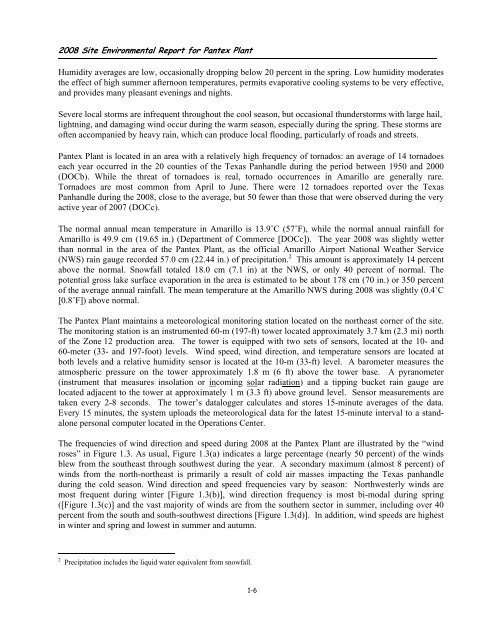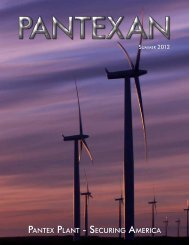2008 Site Environmental Report for Pantex Plant
2008 Site Environmental Report for Pantex Plant
2008 Site Environmental Report for Pantex Plant
You also want an ePaper? Increase the reach of your titles
YUMPU automatically turns print PDFs into web optimized ePapers that Google loves.
<strong>2008</strong> <strong>Site</strong> <strong>Environmental</strong> <strong>Report</strong> <strong>for</strong> <strong>Pantex</strong> <strong>Plant</strong><br />
Humidity averages are low, occasionally dropping below 20 percent in the spring. Low humidity moderates<br />
the effect of high summer afternoon temperatures, permits evaporative cooling systems to be very effective,<br />
and provides many pleasant evenings and nights.<br />
Severe local storms are infrequent throughout the cool season, but occasional thunderstorms with large hail,<br />
lightning, and damaging wind occur during the warm season, especially during the spring. These storms are<br />
often accompanied by heavy rain, which can produce local flooding, particularly of roads and streets.<br />
<strong>Pantex</strong> <strong>Plant</strong> is located in an area with a relatively high frequency of tornados: an average of 14 tornadoes<br />
each year occurred in the 20 counties of the Texas Panhandle during the period between 1950 and 2000<br />
(DOCb). While the threat of tornadoes is real, tornado occurrences in Amarillo are generally rare.<br />
Tornadoes are most common from April to June. There were 12 tornadoes reported over the Texas<br />
Panhandle during the <strong>2008</strong>, close to the average, but 50 fewer than those that were observed during the very<br />
active year of 2007 (DOCc).<br />
The normal annual mean temperature in Amarillo is 13.9˚C (57˚F), while the normal annual rainfall <strong>for</strong><br />
Amarillo is 49.9 cm (19.65 in.) (Department of Commerce [DOCc]). The year <strong>2008</strong> was slightly wetter<br />
than normal in the area of the <strong>Pantex</strong> <strong>Plant</strong>, as the official Amarillo Airport National Weather Service<br />
(NWS) rain gauge recorded 57.0 cm (22.44 in.) of precipitation. 2 This amount is approximately 14 percent<br />
above the normal. Snowfall totaled 18.0 cm (7.1 in) at the NWS, or only 40 percent of normal. The<br />
potential gross lake surface evaporation in the area is estimated to be about 178 cm (70 in.) or 350 percent<br />
of the average annual rainfall. The mean temperature at the Amarillo NWS during <strong>2008</strong> was slightly (0.4˚C<br />
[0.8˚F]) above normal.<br />
The <strong>Pantex</strong> <strong>Plant</strong> maintains a meteorological monitoring station located on the northeast corner of the site.<br />
The monitoring station is an instrumented 60-m (197-ft) tower located approximately 3.7 km (2.3 mi) north<br />
of the Zone 12 production area. The tower is equipped with two sets of sensors, located at the 10- and<br />
60-meter (33- and 197-foot) levels. Wind speed, wind direction, and temperature sensors are located at<br />
both levels and a relative humidity sensor is located at the 10-m (33-ft) level. A barometer measures the<br />
atmospheric pressure on the tower approximately 1.8 m (6 ft) above the tower base. A pyranometer<br />
(instrument that measures insolation or incoming solar radiation) and a tipping bucket rain gauge are<br />
located adjacent to the tower at approximately 1 m (3.3 ft) above ground level. Sensor measurements are<br />
taken every 2-8 seconds. The tower’s datalogger calculates and stores 15-minute averages of the data.<br />
Every 15 minutes, the system uploads the meteorological data <strong>for</strong> the latest 15-minute interval to a standalone<br />
personal computer located in the Operations Center.<br />
The frequencies of wind direction and speed during <strong>2008</strong> at the <strong>Pantex</strong> <strong>Plant</strong> are illustrated by the “wind<br />
roses” in Figure 1.3. As usual, Figure 1.3(a) indicates a large percentage (nearly 50 percent) of the winds<br />
blew from the southeast through southwest during the year. A secondary maximum (almost 8 percent) of<br />
winds from the north-northeast is primarily a result of cold air masses impacting the Texas panhandle<br />
during the cold season. Wind direction and speed frequencies vary by season: Northwesterly winds are<br />
most frequent during winter [Figure 1.3(b)], wind direction frequency is most bi-modal during spring<br />
([Figure 1.3(c)] and the vast majority of winds are from the southern sector in summer, including over 40<br />
percent from the south and south-southwest directions [Figure 1.3(d)]. In addition, wind speeds are highest<br />
in winter and spring and lowest in summer and autumn.<br />
2 Precipitation includes the liquid water equivalent from snowfall.<br />
1-6




